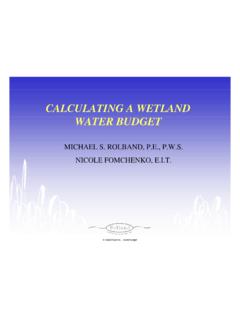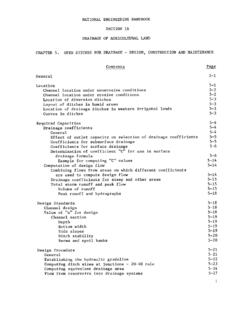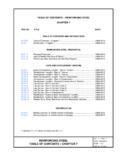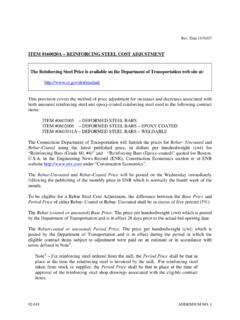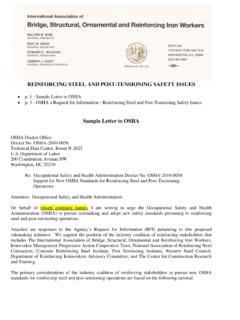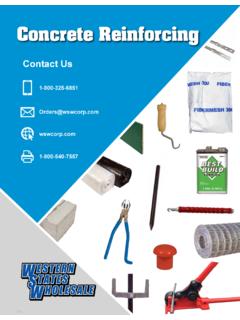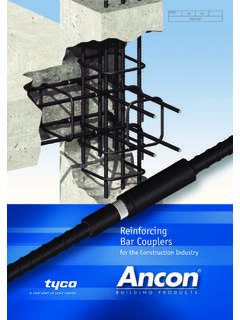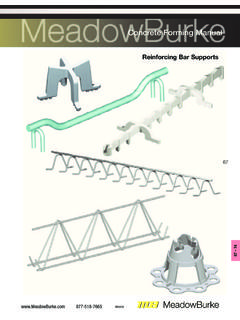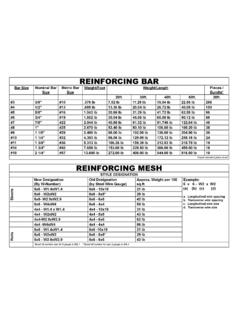Transcription of Welding Reinforcing Steel for Reinforced Concrete
1 U. S. Department of Agriculture Soil Conservation Service Engineering Division Design Branch January 12, 1971 DESIGN 11* Subject: Welding Reinforcing Steel for Reinforced Concrete Welding of Reinforcing bars usually is not necessary in SCS construction and generally should be avoided, unless the saving in other construction costs is sufficient to balance the cost of the control that must be exercised to insure good welds. If a substantial number of large bars, 1/11 or larger, are tb be spliced and there is not room for the required lap to develop the bar strength in bond, Welding may be necessary. However, it usually is more economical, and better structurally, to increase the wall thickness and use smaller' bars which can be lapped. Therefore, generally speaking, the use of 811 or larger bars is not recommended.
2 Tack Welding of Reinforcing bars in lieu of wire tying to hold - / them in place is not permitted by SCS standard specifications. Bars can be seriously weakened by tack Welding . Steel Composition The standard specifications for Reinforcing bars referred to in Material Specification 539, (ASTN A 615, A 616, and A 617) are based on physical properties and do not specify the chemical composition of the Steel . Since weldability is dependent upon chemical composition, bars may conform to these specifications yet not be weldable. If bar splices are to be welded, Material Specification 539 still applies, but the construction details must specify in addition that the bars be of weldable Steel . The contractor should be required to provide a certified copy of the mill test report showing the actual composition of the Steel furnished.
3 Table I shows the ideal range of carbon and manganese in carbon Steel for good weldability. Steels in the range indicated can be welded satisfactorily without special precautions. Preheating, low-hydrogen electrodes, or both, may be required to successfully arc-weld Steel containing more than percent carbon or more than percent manganese. Oxyacetylene Welding can be used for steels with somewhat higher carbon and manganese contents. Thennit Welding can be used for Steel having up to percent carbon and percent manganese. *by A. S. Payne, Assistant Chief, Design Branch Table I - Chemical Analysis of Carbon Steel for Good Weldability Element Carbon Manganese Range, % .06 - .30 .35 - .60 Silicon .10 max. Sulphur .035 max. Phosphorus .030 max. Welding Rods Specifications for arc- Welding electrodes and descriptions of the various classes and their intended uses are given in AWS , "Specification for Mild Steel Covered Arc- Welding Electrodes" of the American Welding Society (ASTM Designation : A233).
4 Similar information for gas- Welding rods is given in AWS , "Specification for Iron and Steel Gas- Welding Rods," (ASTM Designation : AZ5l). Welding Methods The most common method of field Welding is the shielded metal-arc method in which heat to fuse the metal is generated by an electric arc between the Welding rod or electrode and the metal being welded. The electrode is a consumable metal rod coated with a material that gives off an inert gas to prevent contamination of the molten metal by the atmosphere. Oxyacetylene gas Welding , in which the Welding heat is obtained by burning a mixture of acetylene and oxygen, also is used but is slower than electric-arc Welding . Both of these methods, performed byualifjed welders, can produce welds of high quality in steels that are suitable for Welding .
5 Thermit Welding is a process in which the Welding heat is generated by burning "thermit" powder. The essential ingredients of the powder are aluminum, iron oxide, and an igniting agent which react at high temperature to produce molten Steel and alumina slag. Oxides of other elements are added to give the resultiqg weld metal the desired properties. In Welding Reinforcing bars by this process, the bars are clamped in posi- tion in a mold to which is attached a crucible containing the thermit powder. When the powder is ignited, the molten weld metal flows into the mold and between the ends of the bars. The bars and the weld metal are fused together. The process produces welds of good quality and can be used on steels that are hard to weld by other methods.
6 3 The thermit process can pose a serious fire hazard if not handled carefully. The molds and the powder must be protected from moisture, and the bar ends must be clean. A patented process similar to thermit Welding is "Cadweld" rebar splicing in which a metal sleeve is placed around the abutting bar ends and molten metal is cast into the space between the sleeve and the bars. The bars are not fused, however, so this is not a welded splice but depends upon mechanical interlocking of the cast metal with the deformations on the bars and with grooves on the inside of the sleeve. Splice Design The following provisions relating to welded splices in Concrete reinforcement are contained in the ACI standard "Building Code Requirements for Reinforced Concrete " (ACI 318-63), section 805.
7 1. Splices in reinforcement in which the critical desi~ stress is tensile - "Lapped splices in tension shall not be used for bar sizes larger than 811." "Splices at points of maximum tensile stress shall be avoided wherever possible; such splices where used shall be welded, lapped, or otherwise fully developed." 2. Splices in reinforcement in which the critical design stress is compressive - "Welded splices or other positive connections may be used instead of lapped splices. Where the bar size exceeds 1/11, welded splices or other positive connections shall preferably be used. In bars required for compression only,the compressive stress may be transmitted by bearing of square- cut ends held in concentric contact by a suitably welded sleeve or mechanical device.
8 " 3. "An approved welded splice is one in which the bars are butted and welded so that it will develop in tension at least 125 percent of the specified yield strength of the Reinforcing bar.'! 4. Welding shall conform to AWS D , "Recormended Practices for Welding Reinforcing Steel , Metal Inserts and Connections in Reinforced Concrete Construction." Details of several types of welded splice are shown in Figure 1. Welded lap splices should not be used because of the eccentricity of load transfer through them and the resulting tendency to rupture the Concrete . Double lap splices such as illustrated in Figure 1 may be used for small bars in tension or compression. The sleeve splice illustrated in Figure 1 is designed for column bars in compression. Butt splices are good for either tension or compression.
9 Weld Square -end bearing Splice lr angle I ~ I Weld Splice bar Weld (a) SLEEVE SPLICE (b) DOUBLE LAP SPLICES S ing le -Beve 1 Double -Beve 1 Groove Weld Groove We ld Vertical Bars 0 ti-s Sing1 e-Vee Groove Weld Horizontal Bars (c) BUTT SPLICES Fig. 1 - Welded Splices for Reinforcing Steel Welding Procedures Welding procedures should be specified in the construction details. They will depend upon the kind of splice, the size of the bars, the composition of the Steel , the position and accessibility of the welds, the atmospheric temperature, and other factors. Procedures and workmanship should conform to Section 4 of AWS D , " Welding Reinforcing Steel , Metal Inserts and Connections in Reinforced Concrete Construction" and Section 4 of AWS D , "Specifications Lcor Welded Highway and Railway Bridges.
10 If thermit Welding is to be used, procedures should conform to recommendations of the manufacturer of the materials. The thermit powder must be of a composition that will produce weld metal of strength and ductility comparable with that of the bars being spliced, and the quantity used must be sufficient to fill the splice mold and fuse the ends of the bars. Qualification of Welders Since the quality of each weld depends upon the experience and skill of the welder, only welders who have been qualified by tests as prescribed in the "Standard Qualification Procedure" (AWS B ) of the American Welding society1 should be permitted to weld Reinforcing bars. The contractor required to certify that each welder is currently qualified according to the "Standard Qualification Procedure1' and to furnish the dates and results of his qualification tests.
